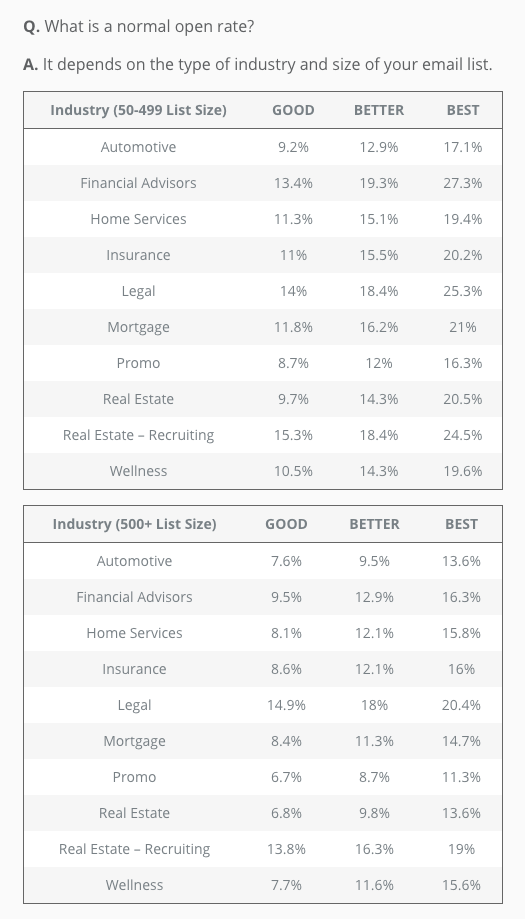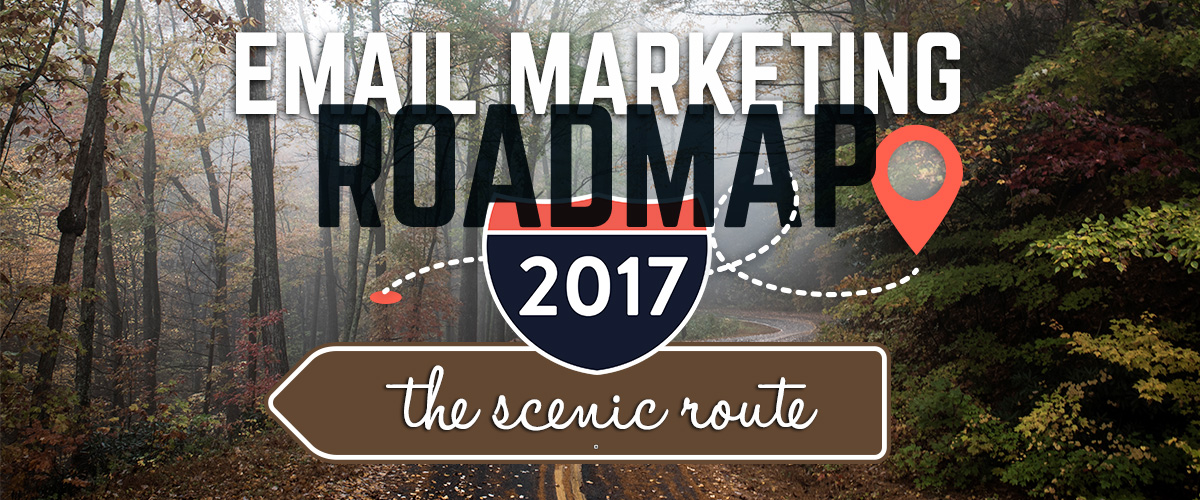Do you know how to interpret your email marketing results? If not, you’re not alone. Forty-nine percent of small business owners say they aren’t sure where to start when interpreting marketing data, and another 40 percent say they don’t have enough time.
But taking the time to review and understand the most important email metrics can make a world of difference in the success of your marketing strategy. Let’s define some of those metrics and learn how they can be used to identify and follow up on warm opportunities.
Email Deliverability
Email deliverability rates show what percentage of sent emails reach their intended destination — clients’ inboxes. If your deliverability rates are down, it’s time to clean your data. Even the best opt-in lists decay 22.5 percent annually as clients change jobs and accounts are abandoned, so database maintenance is imperative.
Not sure where your email deliverability rate should be? Deliverability rates were at 73 in the U.S. in 2015 and 79 percent globally. But for the sake of simplicity, aim for 100 percent!
Email Open Rates
If you’re wondering how many of your delivered emails are being opened, look at the email open rate. This percentage can vary by industry, but 20 percent is a good goal based on reported averages.
Open rate accounts for the size of your list — giving you a ratio that can be benchmarked against industry standards.
Remember: Even the most successful email marketing campaigns fall way below the 100% open-rate mark. (Just look at the table below.)
So what does it mean if your email open rates are suffering?
Consider the following:
- Sender name and email address: If your recipients don’t recognize you, they won’t open your emails.
- Email subject lines: Too long, too vague, too boring? No wonder your open rates are suffering! Be clear, concise (shoot for 50 characters) and enticing.
- Frequency: Send too often and recipients may feel you’re spamming them. Wait too long and they may forget who you are. We recommend starting with a biweekly schedule and testing the waters from there.
- Send time/date: This is one of those stats that seems to vary wildly from one study to the next. The best thing you can do is test different times and dates to see what works best for your audience.
- Mobile users: Sixty-two percent of emails are opened on a mobile device. If your emails aren’t mobile-friendly, you could turn off a huge chunk of your audience.
On the flip side, high email open rates can tell you which email subject lines are working and which content is of the most interest to your audience.
Click-Through Rates
When a recipient clicks on a link in your email, that’s a click-through. Click-through rates show the percentage of opened emails that deliver at least one of these clicks.
Keep in mind that click-through rates are typically low. MailChimp calculated a 2.6 percent average across 46 industries. If your percentages are significantly lower, that could be a red flag. But not all campaigns are designed to generate click-throughs, so consider your goals when evaluating the numbers.
Low click-through rates may indicate a lack of audience engagement. Often this is due to a content/audience mismatch. This can be remedied with list segmentation and more personalized emails, which receive a 10.6 percent higher unique open rate and 100.9 percent more click-throughs.
A weak CTA could also be the problem. Make sure you’re encouraging a clear, logical action. Use buttons and limit unnecessary scrolling to make your CTAs easy to find and click, especially for mobile users.
For more ideas on how to improve email open and click-through rates, check out this chart from Constant Contact.
Using Email Marketing Results to Get Business
It’s important to remember that these aren’t just numbers; these are results that can result in business, if you know how to interpret and apply them.
For example, knowing who is opening your emails gives you the option to follow up on warm opportunities. Thanks to email tracking, you can see when clients are opening your emails and make contact knowing that you’re already top of mind. And if you’ve been tracking click-through rates, you know exactly how to start the conversation.
How to Prioritize Your Follow-Ups
Another thing to pay attention to is email responses. If someone is taking the time to respond to your newsletters, you should follow up on that opportunity. We’ve prioritized these follow-ups according to urgency.
-
Clients who call should get top priority.
Seventy-five percent of consumers consider phone communications to be the most effective way to get a quick response. Don’t let them down!
Example: “Hi, I have a teenage daughter who will get her learner’s permit in a few months. I was reading about this very topic in your latest email newsletter and thought you could help me get her set up with an insurance policy. Can you give me a call back at your earliest convenience?”
-
Clients who email you with an inquiry about your products or services are next in line.
These clients are clearly interested and may even be entering the decision-making stage of the sales funnel. A gentle nudge may be all that’s needed to complete a transaction.
Example: “My AC hasn’t been cooling as well it used to, and after reading your email on maintenance agreements, I realized I haven’t had it serviced in over a year. I’d love to get a professional opinion.”
-
Don’t let new referrals linger, or someone else will snatch them up.
Some of these prospects were forwarded your emails, and others may have asked a friend or family member about your services specifically. Either way, opportunity is knocking.
Example: “I’m looking to buy a new home in your area. I’m not local, but when I asked Chris for a recommendation, he sent me your email newsletter. I learned a lot about the area just reading your articles, so I’m hoping you can help me.”
-
Finally, follow up with the people who reply with content-related, rather than service-related, questions and comments.
Use these opportunities to start a conversation, establish yourself as a trusted expert and form a bond with potential clients.
Example: “That article on oil changes was spot on. My son has been known to drive his car until it’s bone dry, which is truly frustrating considering he was raised by a mechanic! I sent him the article. Fingers crossed!”
Wrap-up
If crunching the numbers isn’t your thing, or you just don’t have time to do it, we can help. Take advantage of our automated email marketing engine. We’ll show you how to interpret and put your marketing results to good use!
Updated: 9/20/17; Originally Published: 5/10/16






![Better Email Etiquette Equals Better Marketing Results [16 Rules]](https://www.outboundengine.com/wp-content/uploads/shutterstock_411184843-1-400x250.jpg)

